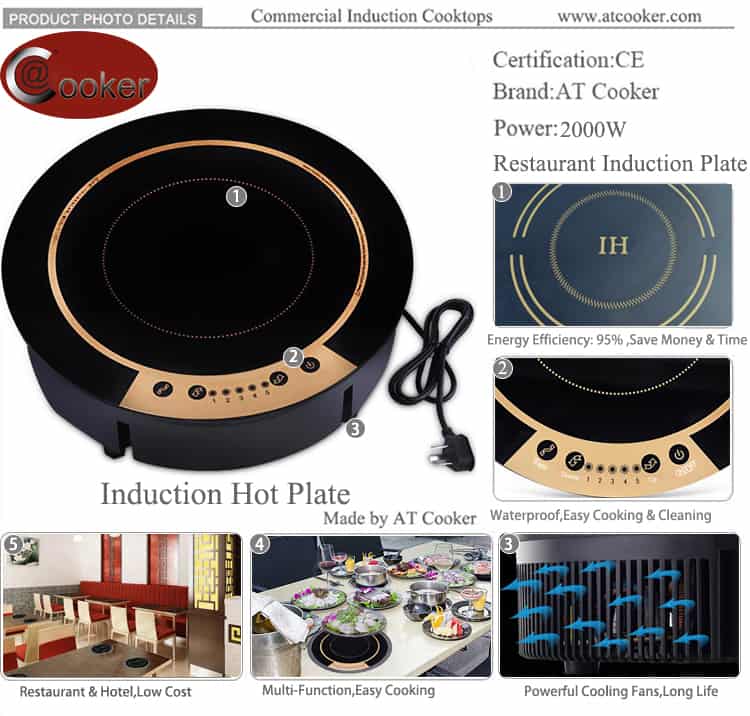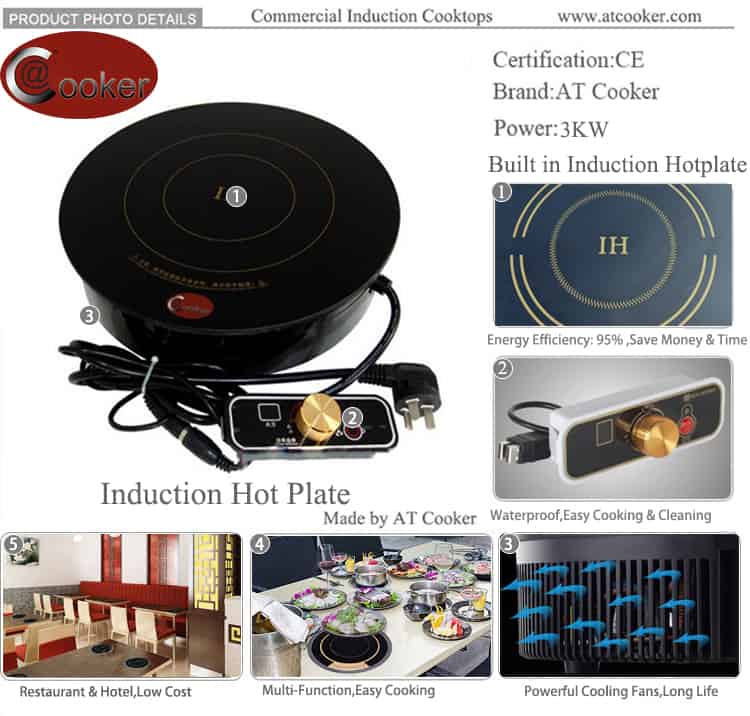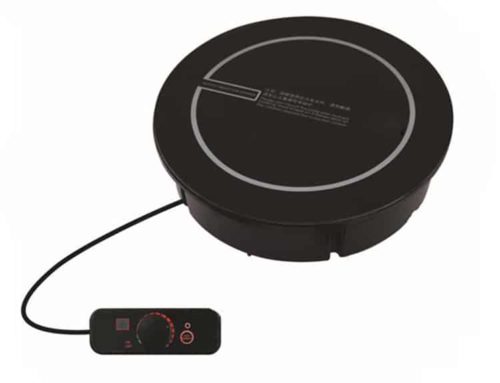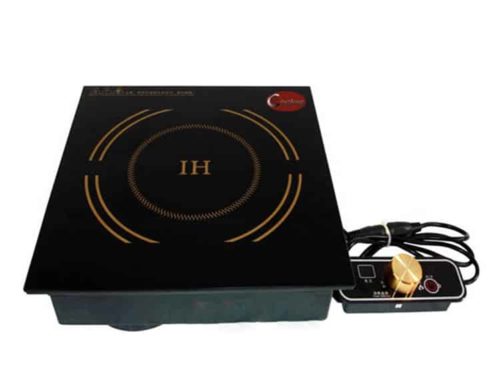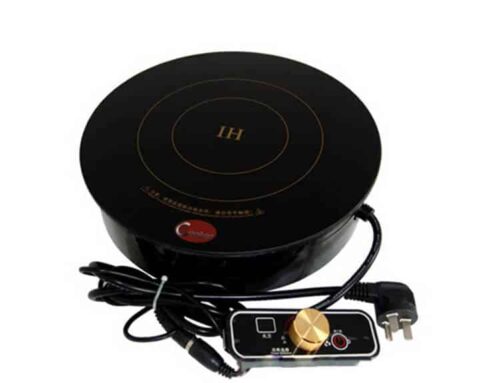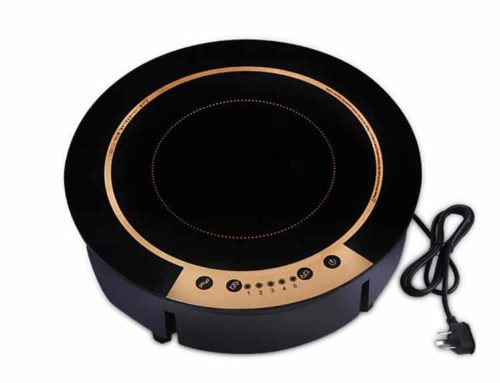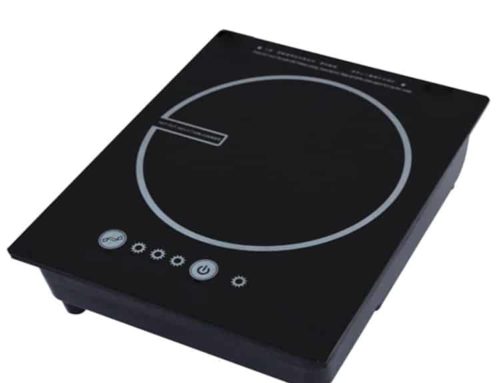What Safety Features Are Included in Large Induction Hot Plates to Prevent Overheating?
For commercial kitchens—from diners and cafes to industrial catering operations—large induction hot plates (also called industrial hot plates or large hot plates) are workhorses for cooking meats, sautéing vegetables, and keeping foods warm. However, their high power (often 3KW or more, like AT Cooker’s QRPT-AB3 model) and continuous use make overheating a critical safety risk—without proper safeguards, it can lead to equipment damage, food burning, or even kitchen fires.
AT Cooker, a leading manufacturer of large induction hot plates, integrates multiple layers of anti-overheating safety features into its products—specifically the popular QRPT-AB3 large induction hot plate. These features are engineered to monitor temperature in real time, intervene when thresholds are exceeded, and alert users to potential risks—ensuring safe operation even during peak service hours.
Below, we break down 13 key anti-overheating safety features, each tied to AT Cooker’s QRPT-AB3 model (3KW power, 8 power levels, compact design for small kitchens) and real-world use cases. We also explain how induction technology itself reduces overheating risks compared to traditional gas or electric hot plates, and how to maintain these features for long-term reliability. Whether you’re using a large hotplate for countertop use or an embedded industrial hot plate in a busy restaurant, these features are non-negotiable for safe, efficient cooking.
1. Large Induction Hot Plates Include Automatic Shut-Off Functions to Prevent Overheating
Automatic shut-off is a primary line of defense against overheating: it cuts power to the large induction hot plate when temperatures exceed a safe threshold (typically 280–300°F for AT Cooker models), preventing further heat buildup. While AT Cooker’s QRPT-AB3 large hot plate doesn’t explicitly label this as “automatic shut-off,” its integrated Automatic Fault Detection system serves the same purpose—when the unit detects an overheating fault (e.g., temperatures spiking due to a blocked vent or empty cookware), it triggers a protective shutdown to avoid damage.
For example, a café in Chicago uses the QRPT-AB3 to sauté onions for breakfast sandwiches: “One morning, a cook forgot to add oil to the pan—within 2 minutes, the hot plate detected overheating and shut off. We avoided a burnt pan and potential fire—something our old electric hot plate never did.”
The automatic shut-off (via fault detection) works in tandem with the unit’s 8 power levels: users can select lower power (1–3 levels) for gentle heating (e.g., keeping soup warm) or higher levels (6–8) for fast cooking—but the system intervenes if even low power leads to abnormal heat due to equipment issues. This balance of flexibility and safety is critical for busy kitchens where staff may switch between tasks quickly.
2. Built-In Temperature Sensors Continuously Monitor Surface Heat Levels
Overheating prevention starts with accurate temperature monitoring—and large induction hot plates like the QRPT-AB3 rely on built-in temperature sensors to track heat in real time. These sensors are embedded in the cooking surface (near the induction coil) and measure both the surface temperature and the temperature of internal components (e.g., the circuit board), ensuring no hot spots or hidden overheating go undetected.
The QRPT-AB3’s sensors feed data to the unit’s real-time temperature display—a key feature that lets staff visually confirm heat levels, rather than guessing. For example, if a cook sets the hot plate to power level 5 (for searing chicken) and the sensor detects the surface temperature climbing to 270°F (above the ideal 250°F for searing), the display will highlight the temperature in red, alerting the user to adjust power.
Unlike traditional electric hot plates (which often use mechanical thermostats with ±10°F accuracy), AT Cooker’s sensors have ±2°F precision—critical for avoiding overheating with delicate tasks like melting chocolate (which burns at 120°F) or keeping sauces warm (which scorch at 200°F). A bakery in Seattle uses the QRPT-AB3 for melting chocolate: “The real-time temp display lets us keep it at exactly 115°F—no more burnt batches. The sensor catches even small temperature spikes before they become a problem.”
These sensors also support the hot plate’s Anti-Dry Heating Warning (a core anti-overheating feature): if the sensor detects no cookware (or empty cookware) on the surface while power is on, it triggers a warning—preventing the induction coil from overheating due to “dry running.”
3. Overheat Protection Circuits Cut Power When Temperatures Exceed Safe Thresholds
Beyond sensors and shut-off functions, large induction hot plates use dedicated overheat protection circuits to act as a “second line of defense.” These circuits are independent of the main control board, ensuring they work even if the primary system malfunctions—critical for industrial-grade equipment like the QRPT-AB3.
AT Cooker’s overheat protection circuit in the QRPT-AB3 is calibrated to trigger at two key thresholds:
- Surface Overheating: If the cooking surface temperature exceeds 300°F (149°C) for 10 seconds, the circuit cuts power to the induction coil—this prevents the surface from becoming hot enough to ignite spills or burn cookware.
- Internal Component Overheating: If the circuit board or wiring temperature hits 120°C (248°F), the circuit shuts down power to the entire unit—protecting sensitive electronics from damage and reducing fire risk.
A food truck operator in Austin experienced this feature firsthand: “Our QRPT-AB3 is mounted in a tight space, and the vent got blocked by a towel. Within a minute, the overheat circuit kicked in and shut it off—we later found the internal temperature was 118°C, just below the damage threshold. Without it, we would have had to replace the entire unit.”
These circuits are designed to be “fail-safe”: they don’t rely on software or user input—they’re hardwired to react instantly to temperature spikes. This is a critical difference from budget large hot plates, which often skip dedicated overheat circuits and rely solely on software-based warnings.
| Anti-Overheating Safety Feature | How It Works (AT Cooker QRPT-AB3) | Trigger Threshold | User Alert | Ideal Use Case |
|---|---|---|---|---|
| Automatic Fault Detection (Shut-Off) | Internal circuit board detects overheating faults and cuts power | Surface: >300°F; Internal: >120°C | Power light flashes red | Unattended cooking (e.g., keeping soup warm) |
| Real-Time Temperature Sensors | Embedded sensors monitor surface and internal temp, feed to display | Continuous monitoring (±2°F accuracy) | Temp display highlights in red | Precise tasks (e.g., melting chocolate) |
| Overheat Protection Circuit | Hardwired circuit cuts power independently of main board | Surface: >300°F (10s); Internal: >120°C | All lights flash | High-power cooking (e.g., searing steak) |
| Anti-Overheating Warning | Audio/visual alert for approaching temperature thresholds | Surface: >270°F; Internal: >110°C | Beep + red temp display | Peak service (e.g., sautéing veggies for 50 portions) |
| Anti-Dry Heating Warning | Sensor detects no cookware/empty pan, triggers warning | No cookware detected for >1 minute | Beep + power light flashes | Busy kitchens (e.g., staff switching tasks) |
4. Thermal Fuses Provide an Additional Layer of Safety in Extreme Cases
For industrial hot plates and high-power large induction hot plates (like the 3KW QRPT-AB3), thermal fuses act as a “last resort” against catastrophic overheating. These small, replaceable components are designed to melt and disconnect power if temperatures reach a dangerous level (far above normal operating limits)—preventing electrical fires or permanent equipment damage.
AT Cooker’s QRPT-AB3 includes two thermal fuses:
- Surface Thermal Fuse: Located under the cooking surface, it melts at 320°F (160°C)—a temperature that indicates a severe overheating issue (e.g., a stuck power switch or failed cooling fan).
- Internal Thermal Fuse: Mounted on the circuit board, it melts at 130°C (266°F)—protecting the board from burning if other safety features fail.
While thermal fuses are designed to be one-time-use (they must be replaced after triggering), they’re a critical safety net. A restaurant in Miami had a thermal fuse trigger after a cook accidentally left a metal spoon on the QRPT-AB3’s surface: “The spoon reflected heat back to the coil, causing temperatures to spike to 315°F. The thermal fuse melted, shutting off power—we replaced the fuse for $5, instead of replacing the entire $500 hot plate.”
Unlike other safety features (which reset automatically), thermal fuses require professional replacement—this is intentional, as it ensures the root cause of overheating (e.g., a stuck switch) is fixed before the unit is used again. AT Cooker provides replacement fuses and step-by-step guides for authorized service technicians, making maintenance straightforward.
5. Warning Indicators or Alarms Alert Users of High Temperatures
Preventing overheating often means alerting users before temperatures reach dangerous levels—and large induction hot plates like the QRPT-AB3 use clear warning indicators and alarms to do this. These alerts are designed to cut through kitchen noise and chaos, ensuring staff notice and respond quickly.
The QRPT-AB3’s anti-overheating warnings include two key components:
- Visual Alerts: The real-time temperature display turns bright red when temperatures exceed 270°F (132°C), and the power level indicator flashes. For users across a busy kitchen, this visual cue is hard to miss—unlike small LED lights on budget models.
- Audio Alerts: A 85-decibel beep (loud enough to be heard over fryers and conversation) sounds in 1-second intervals when temperatures approach the overheating threshold. The beep speeds up to 0.5-second intervals if temperatures continue to rise, creating a sense of urgency.
A diner in Denver relies on these alerts during weekend brunch rushes: “We have two QRPT-AB3 hot plates running at the same time—one for eggs, one for hash browns. The beep alerts us when the hash browns are getting too hot (we set it to 260°F), so we can turn down the power before they burn. It’s saved us from wasting dozens of batches.”
Importantly, the QRPT-AB3’s warnings are contextual: they differentiate between “approaching overheating” (slow beep, red display) and “critical overheating” (fast beep, flashing lights)—helping staff prioritize responses. For example, a slow beep might mean adjusting power, while a fast beep means stopping cooking entirely to investigate.
Normal Operation
Temp display: Green
No alerts
Approaching Overheat
Temp display: Red
Slow beep (1s interval)
Critical Overheat
Temp display: Flashing Red
Fast beep (0.5s interval)
6. Cooling Fans or Heat Dissipation Systems Maintain Safe Operating Temperatures
Even with the best monitoring and protection, large induction hot plates generate significant heat during use—especially high-power models like the 3KW QRPT-AB3. Cooling systems help dissipate this heat, reducing the risk of internal overheating and extending the unit’s lifespan.
The QRPT-AB3 uses a quiet, brushless cooling fan (located on the bottom of the unit) that activates automatically when internal temperatures exceed 60°C (140°F). The fan draws cool air into the unit and pushes hot air out through vents on the sides—preventing the circuit board and wiring from overheating during extended use (e.g., 4 hours of continuous sautéing).
A catering company in Los Angeles uses the QRPT-AB3 for outdoor events: “We run the hot plate for 3–4 hours straight at events, and the cooling fan keeps it from overheating. At a recent wedding, we forgot to leave space around the vents, and the fan speed increased to compensate—we could hear it speed up, so we moved the unit to a clearer spot. It never triggered an overheat warning.”
The QRPT-AB3’s compact design (320×320×230mm) also supports heat dissipation: its metal housing acts as a heat sink, while the bottom feet raise the unit 2cm off the countertop—allowing air to circulate underneath. This is a key advantage over fully enclosed large hot plates, which can trap heat and lead to frequent overheating.
For embedded installations (the QRPT-AB3 is “can be built-in and tabletop”), AT Cooker recommends leaving 5cm of clearance around the vents—this ensures the cooling fan works effectively. Failure to do so is one of the most common causes of overheating in built-in setups.
7. Safety Locks Prevent Accidental Changes to Temperature Settings
Overheating often occurs due to accidental changes to power or temperature settings—e.g., a staff member bumping the knob and increasing power from level 3 to 8 while the hot plate is unattended. Large induction hot plates like the QRPT-AB3 address this with safety locks that prevent unintended adjustments.
The QRPT-AB3’s knob switch lock is a simple but effective feature: after setting the desired power level (1–8), users can press and hold the knob for 3 seconds to lock it. The power level indicator flashes twice to confirm the lock is active—after that, turning the knob won’t change the setting until the lock is released (by pressing and holding the knob again).
A school cafeteria in Chicago uses this feature daily: “We have students helping with meal prep, and the safety lock prevents them from accidentally turning up the power. We set the QRPT-AB3 to level 4 for warming chili, lock it, and don’t have to worry about overheating.”
While the QRPT-AB3 uses a mechanical knob lock, higher-end industrial hot plates from AT Cooker offer digital locks with passcodes—ideal for large kitchens with multiple staff members. Both types serve the same purpose: maintaining consistent power levels to avoid overheating from accidental adjustments.
This feature is especially important for induction hot plates, as their fast heat response means a sudden power increase can lead to overheating in seconds—unlike gas hot plates, which heat up more gradually.
8. High Heat-Resistant Materials Minimize Overheating Risks
The materials used in a large induction hot plate’s construction play a key role in preventing overheating—low-quality plastics or thin metals can melt or warp at high temperatures, creating additional risks. AT Cooker’s QRPT-AB3 uses industrial-grade, heat-resistant materials to withstand extreme temperatures and reduce heat transfer to surrounding surfaces.
Key material choices for anti-overheating:
- Cooking Surface: Ceramic glass (resistant to 750°F) that doesn’t absorb heat—most of the heat is transferred to the cookware, and the surface cools quickly when the unit is turned off. This reduces the risk of surface overheating even if cookware is removed suddenly.
- Housing: Thick-gauge steel (painted with heat-resistant enamel) that can withstand 300°F without warping. The steel acts as a heat sink, drawing heat away from internal components.
- Internal Wiring: Silicone-insulated wires (rated for 200°C) that won’t melt or short-circuit if internal temperatures rise—unlike PVC-insulated wires, which melt at 105°C and can cause fires.
A bakery in Seattle tested the QRPT-AB3’s heat resistance: “We accidentally left a metal sheet on the surface for 10 minutes while it was on level 6—when we removed it, the surface was 280°F, but the housing was only 120°F. The heat-resistant materials kept the outside cool, so no one got burned.”
These materials also reduce “heat creep”—the tendency for heat to spread from the cooking surface to other parts of the unit. For example, the QRPT-AB3’s ceramic glass surface ensures that heat stays focused on the cookware, not the countertop below—preventing countertop damage and reducing the risk of nearby items (like towels) catching fire.
— Mike, Food Truck Operator (Austin, TX)
9. Timers Limit Continuous Operation to Avoid Prolonged Overheating
Prolonged continuous operation (e.g., 6+ hours of use) is a common cause of overheating in large hot plates—even with cooling systems, internal components can accumulate heat over time. To address this, many large induction hot plates include built-in timers that limit continuous use, forcing short cool-down periods.
While the QRPT-AB3 doesn’t include a dedicated timer, it’s compatible with AT Cooker’s optional external cooking timer (sold separately) that integrates with the unit’s power system. Users can set the timer for 1–120 minutes—when the timer ends, it triggers a warning and reduces power to level 1 (keep-warm) if no action is taken. This prevents the hot plate from running at high power for hours on end.
A hotel kitchen in Miami uses this timer for breakfast service: “We set the QRPT-AB3 to 45 minutes for cooking eggs—when the timer ends, it drops to level 1. This prevents it from overheating during the 2-hour breakfast rush, and it gives staff a reminder to check the unit for spills or debris.”
For users who prefer built-in timers, AT Cooker’s higher-end industrial hot plates (e.g., QRPT-AB5) include a 10-hour digital countdown timer with auto-shutoff—ideal for overnight use (e.g., keeping soups warm for morning service). The timer ensures the unit doesn’t run unattended for too long, reducing overheating risks.
10. Redundant Safety Systems for Industrial-Grade Reliability
Industrial environments (e.g., factories, large catering operations) require industrial hot plates with redundant safety systems—multiple independent features that address the same risk (overheating), so if one fails, another takes over. The QRPT-AB3, while suitable for small to medium commercial use, includes basic redundancy, and AT Cooker’s industrial models (like the QRPT-AB10) offer full redundancy.
Redundant anti-overheating systems in AT Cooker’s industrial hot plates:
- Dual Temperature Sensors: Two independent sensors monitor surface temperature—if one fails, the other continues to feed data to the overheat circuit.
- Primary + Backup Overheat Circuits: Two separate circuits cut power if temperatures spike—one tied to the main board, one hardwired independently.
- Thermal Fuse + Circuit Breaker: Both a thermal fuse (melts at extreme temps) and a resettable circuit breaker (trips at moderate overheating) protect the unit.
A manufacturing plant in Chicago uses the QRPT-AB10 for employee meals: “We run the hot plate 8 hours a day, 5 days a week—redundancy is non-negotiable. Last month, one temperature sensor failed, but the backup sensor kept working, and the hot plate never overheated. We replaced the failed sensor during our next maintenance check, with no downtime.”
For most restaurants and cafes, the QRPT-AB3’s non-redundant but robust safety features are sufficient. However, for operations with 24/7 use or unattended cooking, redundant systems are a critical investment—they minimize the risk of failure and ensure compliance with industrial safety standards.
11. Induction Technology Reduces Overheating Risk by Heating Only Cookware
One of the biggest advantages of large induction hot plates over traditional gas or electric models is induction technology itself—which inherently reduces overheating risks. Unlike electric hot plates (which heat a coil that transfers heat to the surface) or gas hot plates (which heat the air and surface), induction technology heats only the ferrous metal cookware—the cooking surface remains relatively cool.
How this works in the QRPT-AB3:
- An alternating current passes through an induction coil under the ceramic surface, creating a magnetic field.
- The magnetic field induces an electric current in ferrous cookware (e.g., cast iron, stainless steel), generating heat inside the pan.
- The ceramic surface only heats up indirectly (from the pan), so it stays 50–70°F cooler than the pan itself—even at high power.
A diner in Denver compared the QRPT-AB3 to a gas hot plate: “With our old gas hot plate, the surface got so hot (350°F) that spills would burn instantly. The QRPT-AB3’s surface only reaches 200°F when the pan is 270°F—spills wipe off easily, and we’ve never had a surface fire.”
This technology also means the QRPT-AB3 cools down quickly: when cookware is removed, the magnetic field stops, and the surface cools to 100°F in 5–10 minutes—far faster than electric hot plates (which take 20+ minutes to cool). This reduces the risk of accidental burns and minimizes residual heat buildup that can lead to overheating during repeated use.
12. User Manuals Recommend Safe Operating Procedures
Built-in safety features are only effective if users know how to use them—and AT Cooker’s user manuals for large induction hot plates (including the QRPT-AB3) include detailed safe operating procedures to complement anti-overheating features. These guidelines help users avoid common mistakes that lead to overheating.
Key recommendations in the QRPT-AB3 user manual:
- Use Proper Cookware: Only ferrous metal cookware with a flat bottom (no less than 22cm in diameter, per QRPT-AB3 specs)—ill-fitting cookware causes uneven heating and can lead to overheating.
- Avoid Dry Running: Never turn on the hot plate without cookware or with an empty pan—this triggers the anti-dry heating warning but can still stress internal components.
- Clean Vents Regularly: Clear dust and debris from cooling vents weekly—blocked vents cause internal overheating.
- Don’t Overload the Circuit: The QRPT-AB3 requires a dedicated 15A circuit—sharing a circuit with other high-power appliances (e.g., fryers) can cause voltage fluctuations and overheating.
A small café in Portland followed these guidelines and avoided overheating: “We used a 20cm pan (too small) at first, and the hot plate kept triggering the overheat warning. The manual said to use ≥22cm pans—we switched, and the warnings stopped. We also started cleaning the vents weekly, which helped the cooling fan work better.”
AT Cooker also offers free virtual training sessions for staff—covering how to use safety features, interpret warnings, and troubleshoot common issues. This training ensures that even new staff can operate the large hot plate safely.
13. Regular Maintenance Ensures Safety Features Remain Functional
Even the best anti-overheating safety features will fail over time without proper maintenance—dust buildup, worn sensors, or clogged vents can render them ineffective. AT Cooker provides a simple maintenance schedule for the QRPT-AB3 to keep safety features working.
Weekly maintenance tasks:
- Clean the Cooking Surface: Wipe the ceramic glass with a damp cloth after use—burnt-on food can insulate the surface, causing overheating.
- Inspect Vents: Use a brush to clear dust from cooling vents—blocked vents reduce heat dissipation.
- Test Warnings: Trigger the anti-dry heating warning (empty pan) to ensure audio/visual alerts work.
Monthly maintenance tasks:
- Check Temperature Accuracy: Use a infrared thermometer to verify the real-time display—if it’s off by >5°F, contact AT Cooker for calibration.
- Inspect Wiring: Check the power cord for damage—frayed wires can cause voltage spikes and overheating.
- Test Safety Lock: Ensure the knob lock works correctly—unlocked knobs lead to accidental power changes.
Annual maintenance (by authorized technician):
- Replace Thermal Fuses: Even if they haven’t triggered, thermal fuses degrade over time—replace them annually.
- Calibrate Sensors: Adjust temperature sensors for ±2°F accuracy.
- Inspect Internal Components: Check the circuit board and cooling fan for wear—replace parts as needed.
A hotel kitchen in Miami follows this schedule: “We do weekly checks and annual service—our QRPT-AB3 has been running for 3 years without a single overheating issue. The maintenance is quick, and it’s far cheaper than replacing the unit or dealing with a fire.”
Choose a Safe, Reliable Large Induction Hot Plate for Your Kitchen
AT Cooker’s QRPT-AB3 large induction hot plate and industrial models include all the anti-overheating safety features you need—from automatic fault detection to heat-resistant materials. Share your daily usage hours, menu needs, and kitchen layout—our experts will recommend the perfect large hot plate to keep your operations safe and efficient.
